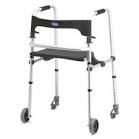Look at the image of the walker. Most of us have the first reaction that we are glad we do not have to use one to move from place to place. In visiting a patient who temporarily had to use a walker during her inpatient rehabilitation process following surgery, I saw the walker from a different perspective. For this patient the walker one component of a process that lead her to the point where she can walk without assistance and without constant pain. I saw her the day she was being discharged and she felt her surgery and recovery were fantastic. When she said how helpful the use of a walker had been I said to myself, “No one has ever told me that before.” So today in addition to celebrating healing with a patient, I learned to view a walker from a different perspective. That is something that is good for all of us to learn from others a different way of viewing objects we see all the time.
Monthly Archives: May 2015
May 11 – Dependability as a foundation in building a relationship
Today I attended a funeral visitation for the mother of an employee of the health system. As she introduced me to members of her family she followed after giving my name and title by saying, “He is always just a phone call away”. I had not expected that “tag on” to the introduction.
As I reflected on the comment on the way home I realized that in that relationship as well as many others, people value dependability. If you think of a relationship as being made of building blocks, I would say dependability is one of the most important building blocks in a relationship – whether the relationship is personal or professional. That is why I chose the image of blocks for today’s post.
On the topic of dependability I thought about the people I depend on in my life. Some are people from the health system, others are from churches in the area, and others are people I have known for a significant part of my life, whom I met prior to making the trek from Illinois to Maryland. I am thankful for the people that I know and depend on, and I hope you are able to think of people that you can depend on as you read this post.
May 6 – The Concept of Moral Dissonance
I am attending a workshop on how to function effectively where moral dissonance exists. Moral dissonance exists when what you are hearing or being asked to do is in conflict with your moral beliefs. You will notice the people in the picture I have chosen have concerned contemplative expressions on their faces, rather than expressions of joy. I would love life if every encounter I faced was one of joy!! The truth is that is an unrealistic expectation.
For some patients and their families the option that is advocated by the physicians is not one they can easily embrace because of their moral beliefs. Some amount of conflict arises in these situations. The training I am receiving this week will help me listen to the patient and/or family express their dilemma and then allow me to help them look at the option that is being suggested by the physician and the option they are looking at that comes from their own thought processes. The ideal outcome is not to force anyone into making a decision they are morally against. The outcome is to help people think about the decision from a different perspective and in some cases include facts and beliefs in the discussion that up to this point have not been included.
By listening and responding in an atmosphere that affirms the moral values of the patient and/or family, the goal is to help them make the best care plan decision possible given the specific circumstances of the illness and treatment options that are available.



